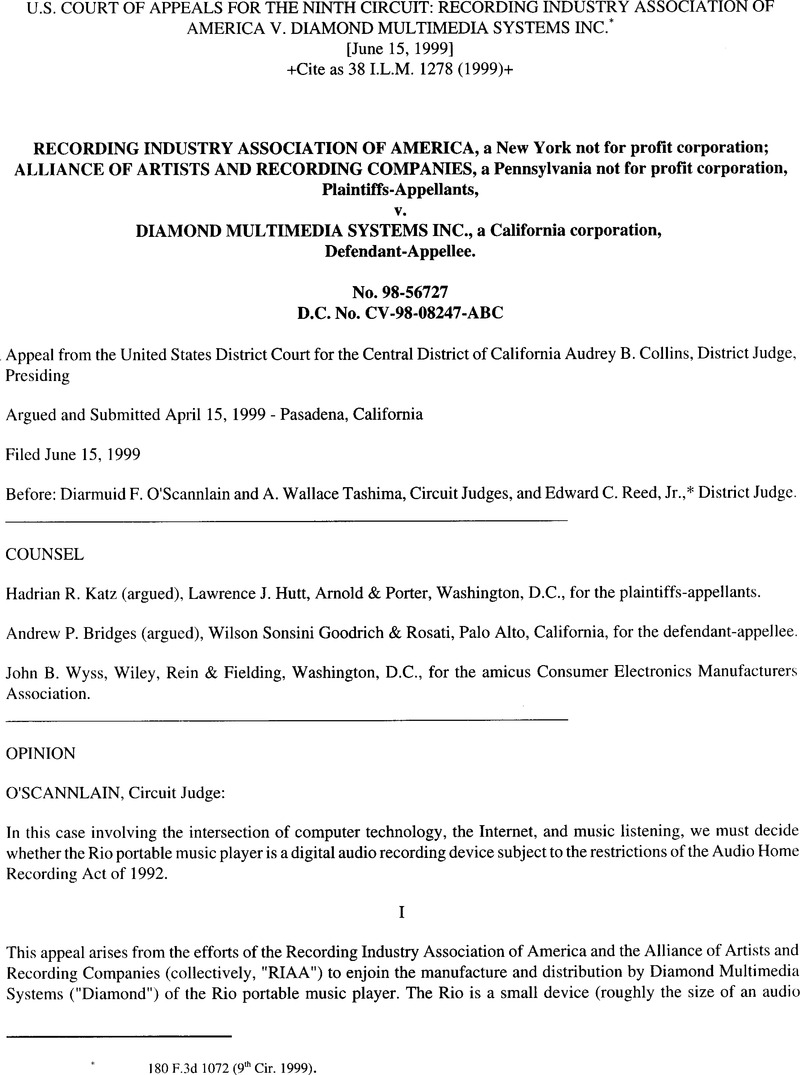Article contents
U.S. Court of Appeals for the Ninth Circuit: Recording Industry Association of America v. Diamond Multimedia Systems Inc
Published online by Cambridge University Press: 27 February 2017
Abstract

- Type
- Judicial and Similar Proceedings
- Information
- Copyright
- Copyright © American Society of International Law 1999
Footnotes
180 F.3d 1072 (9th Cir. 1999).
References
Endnotes
* The Honorable Edward C. Reed, Jr., Senior United States District Judge for the District of Nevada, sitting by designation.
1 Whether or not piracy causes such financial harm is a subject of dispute. Critics of the industry's piracy loss figures have noted that a willingness to download illicit files for free does not necessarily correlate to lost sales, for the simple reason that persons willing to accept an item for free often will not purchase the same item, even if no longer freely available. See Kurlantzick, Lewis ' Pennino, Jacqueline E., The Audio Home Recording Act of 1992 and the Formation of Copyright Policy, 45 J. Copyright Soc'y U.S.A. 497, 506 (1998).Google Scholar Critics further note that the price of commercially available recordings already reflects the existence of copying and the benefits and harms such copying causes; thus, they contend, the current price of recordings offsets, at least in part, the losses incurred by the industry from home taping and piracy. See id. at 509-10.
2 At the time the preliminary injunction was sought and denied, the Rio did not incorporate SCMS; Diamond asserts that it has now incorporated such a system into the Rio Manager software, though not into the Rio itself.
3 We can, of course, affirm on any grounds supported by the record, see Gemtel Corp. v. Community Redevelopment Agency of City of Los Angeles, 23 F.3d 1542, 1546 (9th Cir. 1994), thus, we can affirm even if the lower court relied on incorrect grounds or faulty reasoning, see Aronson v. Resolution Trust Corp., 38 F.3d 1110, 1114 (9th Cir. 1994).
4 There is no precedent (other than the district court's order) to guide the panel's interpretation of the Act. The Act has only been discussed once in a published opinion by another federal court, and there, only to explain why it had no effect on the Copyright Act provisions at issue in that case. See ABKCO Music, Inc. v. Stellar Records, Inc., 96 F.3d 60, 65-66 (2d Cir. 1996) (rejecting the contention that the Act changed or affected the definition of “phonorecord” in the Copyright Act).
5 The Senate Report discusses the original term “audiogram,” which was replaced by the term “digital music recording,” but the two definitions are nearly identical, with the only difference being the deletion from the “audiogram” definition of examples of material objects in which things other than sounds are fixed. Compare S. Rep. 102-294, at *4-5 (“An ‘audiogram’ is a material object (i) in which are fixed, by any method now known or later developed, only sounds (and not, for example, a motion picture or other audiovisual work even though it may be accompanied by sounds), and material, statements or instructions incidental to those fixed sounds, if any, and (ii) from which the sounds and material can be perceived, reproduced, or otherwise communicated, either directly or with the aid of a machine or device.“) (emphasis added), with 17 U.S.C. § 1001(5)(A) (“A ‘digital music recording’ is a material object — (i) in which are fixed, in a digital recording format, only sounds, and material, statements, or instructions incidental to those fixed sounds, if any, and (ii) from which the sounds and material can be perceived, reproduced, or otherwise communicated, either directly or with the aid of a machine or device.“). Thus, comment in the legislative history regarding the “audiogram” definition are relevant to our interpretation of the “digital music recording” definition.
6 Indeed, Diamond asserted at oral argument (and supports the assertion with the affidavit of a direct participant in the negotiations and compromises that resulted in the final language of the Act) that the exclusion of computers from the Act's scope was part of a carefully negotiated compromise between the various industries with interests at stake, and without which, the computer industry would have vigorously opposed passage of the Act.
7 We further note that any transmission reproduced indirectly must pass through a computer, as an MP3 file, to reach the Rio. As we explained in part III.B.2, supra, computers are exempted from the requirement of reading and transmitting SCMS codes, and MP3 files do not incorporate such codes. Thus, requiring the Rio to implement SCMS because it can indirectly reproduce a transmission of a digital music recording would be, as the district court concluded, “an exercise in futility.” RIAA I, 29 F. Supp. 2d at 632. SCMS would not alter the Rio's ability to reproduce such transmissions, just as it would not alter the Rio's ability to reproduce digital music recordings uploaded to a computer hard drive.
- 1
- Cited by




